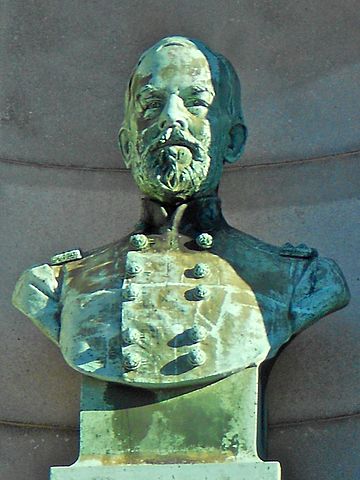James A. Beaver facts for kids
Quick facts for kids
James A. Beaver
|
|
|---|---|

Beaver pictured in La Vie 1908, Penn State yearbook
|
|
| 20th Governor of Pennsylvania | |
| In office January 18, 1887 – January 20, 1891 |
|
| Lieutenant | William T. Davies |
| Preceded by | Robert E. Pattison |
| Succeeded by | Robert E. Pattison |
| President of the Pennsylvania State University Acting |
|
| In office 1906–1908 |
|
| Preceded by | George W. Atherton |
| Succeeded by | Edwin Erle Sparks |
| Personal details | |
| Born | October 21, 1837 Millerstown, Pennsylvania |
| Died | January 31, 1914 (aged 76) Bellefonte, Pennsylvania |
| Political party | Republican |
| Profession | Attorney |
| Signature | |
James Addams Beaver (born October 21, 1837 – died January 31, 1914) was an important person in Pennsylvania history. He was a lawyer and a brave soldier during the American Civil War. He was even wounded four times! Later, he became the 20th Governor of Pennsylvania. He also served as the temporary president of the Pennsylvania State University for a few years.
Early Life and Education
James Beaver was born in Millerstown, Pennsylvania. His father died in 1840, so his mother taught him until 1846. Then, his family moved to Belleville, and he started going to school.
In 1852, he went to Pine Grove Academy. Two years later, in 1854, he joined Jefferson College. He graduated from Jefferson College in Canonsburg, Pennsylvania in 1856. Today, this college is known as Washington & Jefferson College.
After college, James studied law with a lawyer named H.N. McAllister. He became a partner in the law firm as soon as he was old enough. During this time, he joined a local military group called the "Bellefonte Fencibles." He studied military tactics carefully. When President Abraham Lincoln asked for volunteers in 1861, James was ready to help defend the country.
A Brave Soldier in the Civil War
When the 45th Pennsylvania volunteers were formed, James became their lieutenant-colonel. He first saw action near Hilton Head Island, South Carolina and Port Royal, South Carolina. In 1862, he became the colonel of the 148th Pennsylvania volunteers. These soldiers were from his home area. James was a great leader, and his men were very disciplined. People often thought they were professional soldiers!
His regiment joined the army after the Battle of Fredericksburg. They fought bravely at the Battle of Chancellorsville in May 1863. They were in a very dangerous spot and lost many soldiers. Colonel Beaver was also wounded in this battle.
Even though he was still recovering, James helped recruit new soldiers. He rejoined his regiment just before the famous Battle of Gettysburg. He was still too weak to lead them in that fight. However, he led his regiment through the tough Overland Campaign in May 1864. They successfully attacked enemy defenses at Spotsylvania Courthouse, Virginia. His regiment was among the first to break through.
At the Battle of Cold Harbor in June 1864, James was put in charge of his brigade. His general was wounded. James was also slightly wounded, but he kept fighting. He stayed at his post all day, holding a dangerous position close to the enemy.

On June 16, 1864, he was wounded again while leading his brigade at Petersburg. He returned to duty before his wound was fully healed. At the Second Battle of Ream's Station, his right leg was shattered by a rifle ball. He was only 26 years old. His leg had to be amputated, meaning it was removed. This meant he could no longer serve actively in the military.
James was honored as a brigadier general in November 1864. He left the army in December that year. He had been offered promotions that would take him away from his regiment, but he always refused. He felt it was important to stay with the men he had enlisted.
Governor of Pennsylvania
After the war, James Beaver continued his law career. He became a member of the board of trustees for the Pennsylvania State University in 1873. He also gave many speeches for the Republican Party.
He turned down offers to run for public office for a long time. He even said no to being vice president on James Garfield's Republican ticket in 1881. He ran for governor in 1881 but lost. However, Pennsylvania's rules said a governor could not serve two terms in a row. So, when the next election came, James Beaver ran again. He won and served as governor from 1887 to 1891. He was governor for the four years between Robert Pattison's two terms.
In 1895, he was chosen to be one of the judges for the first state Superior Court. He held this important job until he passed away in 1914. He was buried in Union Cemetery in Bellefonte, Pennsylvania. He was also a well-known member of the Grand Army of the Republic, a group for Civil War veterans.
Today, places at Pennsylvania State University are named after him. These include Beaver Stadium and Beaver Hall on the University Park campus. Also, Beaver Avenue in State College, Pennsylvania is named in his honor.

